Expertise
Gamification: an innovative customer loyalty strategy
7 minutes

Gamification offers brands many benefits, including through discovery and sharing, as well as personalized experiences for users.
In this article, we explore the benefits of gamification and how it can help you keep your customers engaged.
Before we begin, let’s set the scene again by defining and explaining the concept of gamification.
- Gamification (or the integration of gaming elements into a non-gaming context) is a marketing strategy aimed at increasing user engagement and motivation. By introducing gaming elements into the buying journey, it aims to make tasks more stimulating and enhance the user experience.
- The aim is to use the stimulation and interactivity offered by games to encourage desired behaviors. Gamification doesn’t necessarily mean creating a game in its own right, but rather adding game elements at some point in the customer experience to make it more engaging.
The history of gamification dates back to the 1980s, with the appearance of the first video games
However, the term gamification didn’t become popular until the early 2000s and the advent of digital. Since then, gamification has grown exponentially, with the emergence of new technologies and the increasing adoption of the use of games in various sectors. Over the past few decades, gamification has become a marketing strategy in its own right. Brands have begun to use gamification to increase customer engagement, improve brand loyalty and boost sales.
It’s important to note that gamification is not a quick fix. It must be used strategically and thoughtfully to be effective. This means understanding the needs and motivations of each audience, and designing a shopper experience that meets their needs, in an attractive and engaging way.
Is gamification a lever for recognition and social dimension?
Gamification, an increasingly popular marketing strategy, responds effectively to shoppers’ need for recognition and social dimension. The need for recognition, a key element of motivation, is stimulated by tangible rewards. Whether in the form of points, badges, rankings or prize draws, they offer visible recognition of the efforts made by the digital shopper, thereby increasing participant engagement.
Gamification creates an enjoyable and unique shopping experience, associated with the values of each retailer. This attracts the attention of shoppers and builds emotional bonds with them until they become loyal customers.
The social dimension is reinforced by interactivity, another lever of gamification: games, by their very nature, encourage interaction. In a gamification context, this means strengthening ties between participants, stimulating collaboration and enhancing the user experience.
However, gamification is not a one-size-fits-all solution. To be effective, it must be well conceived and implemented. It must be adapted to the needs and expectations of participants, and aligned with corporate objectives.
Gamification must be intuitive, user-friendly and simple. To ensure that users don’t lose motivation, it’s essential that the game is intuitive and the rules clear, otherwise shoppers won’t have the time or patience to follow through, and this will have a negative impact on participation KPIs.
In short, gamification should not be used simply for the pleasure of offering a form of gaming, but should serve a broader objective, and primarily a business and/or engagement objective.
“Gamification is a powerful way to increase conversions to online purchase. You can offer your customers benefits at the end of their shopping experience, instantly. Like ultra-personalized discount coupons or a game at the end of the shopping journey to try and win a refund for their shopping cart. It’s a powerful lever for any manufacturer or retailer”.
Romain Charles, CEO Lucky cart
Gamification, yes, but how do you integrate it into your marketing strategy?
Integrating gamification into a company’s marketing strategy requires a thorough understanding of its objectives.
A study conducted by Techvalidate revealed that 30% of companies that integrated gamification into their strategies improved their conversion rate by +50%*.
These objectives can be anything from improving productivity and increasing customer engagement, to encouraging innovation and business performance. Once these objectives have been clearly defined, a brand can begin to integrate this strategy into its marketing plans.
Implementing gamification requires involvement at all levels of the company, and also (and above all) the right resources.
At Lucky cart, we offer turnkey digital solutions that combine an understanding of brand issues with the data processing required to implement each strategy. Because in reality, without key information on digital shoppers, their desires, needs, purchasing behaviors and even their purchase forecasts, no gamification action will be beneficial.
All the more so as our CSM teams manage over 500 digital activations a year. In addition to putting them on line, we create them according to the identified needs of our industrial and retail customers, then orchestrate them across the 90% of our drive partners, and finally adjust them on an ongoing basis. Our sole aim is to enhance performance, visibility and, ultimately, profitability.
In other words, we offer you simple, easy, fun and effective turnkey digital solutions!
But why? Because we’ve found that brands that integrate gamification into their marketing strategies perform much better in terms of shopper engagement:
+47% engagement,
+22% brand loyalty,
+15% brand awareness*.
Of course, these figures are averages, but they are averages that speak for themselves and prove that it works.
And how do you measure the success of a gamification strategy?
Measuring the success of a gamification strategy depends on the specific objectives defined upstream.
If the objective is to improve customer engagement, then we’ll monitor game participation rates, the number of winners… If the main KPI’s is to generate additional business, then we’ll monitor ROI.
At Lucky cart, we take particular care in producing end-of-campaign reports. Orchestrated by our Business Insights teams, our challenge is to provide a complete mapping of the major KPI’s that we manage: calculation of incremental sales by AB/Test, breakdown of incremental sales by shopper type, visibility… We are well aware that the ultimate aim of our actions remains the generation of additional business: our market universe is highly competitive. Brands use our solutions to stand out from the crowd and increase their visibility among digital shoppers using our retail partners’ drive platforms. We are the only player to cover 90% of the French Drive network, and it’s this national coverage that manufacturers are looking for.
What are the prospects for gamification?
Gamification, an ever-evolving trend, has the potential to transform many sectors. One of the most promising prospects is the use of gamification to create immersive experiences, which could lead to even more engaging and effective gamification experiences.
By transforming interaction with a brand or product into a playful experience, gamification can play a key role in loyalty and engagement. An excellent means of building loyalty and, ultimately, generating business, this strategy can only pay off on one condition: define the right strategy, the right target digital assets combined with knowledge of shopper data. The grail for all: knowledge of customers’ needs to better address them with quality communication and strengthen their loyalty.
At Lucky cart, this has been our business for many years. We don’t just make our digital activations fun, we also personalize them, down to the individual. Indeed, having so much data at our disposal enables us to tailor our communications to each digital shopper, whether in terms of the products on offer (purchase prediction), the number of products to buy (purchase history) or the amount of the offer.
Our teams are experts in their field, and our products meet your needs, so let’s talk!
Sources :
*Sortlist :
https://www.sortlist.fr/blog/gamification-marketing/
Snipp :https://www.snipp.com/blog/2017-06-21/the-power-of-gamification-participation-engagement-loyalty



